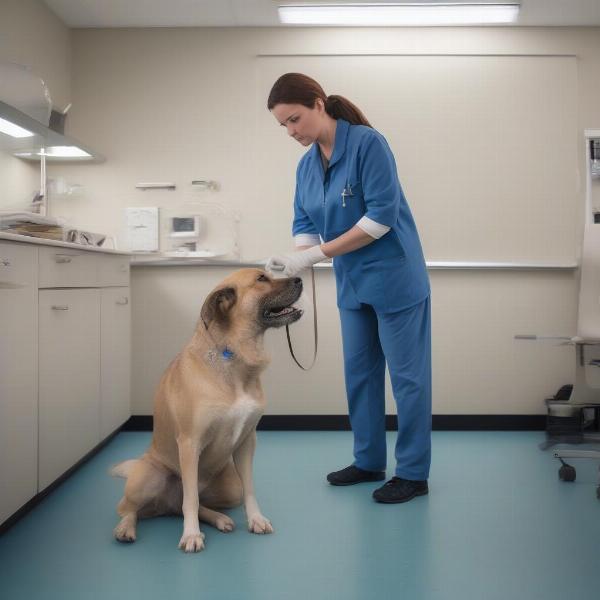Gait analysis in dogs is a valuable tool for assessing their musculoskeletal health. By observing how your dog walks, trots, and runs, veterinarians and other professionals can identify subtle abnormalities that may indicate underlying issues. Understanding the basics of gait analysis can also help owners recognize potential problems early on, leading to quicker intervention and improved outcomes. This article will explore what gait analysis involves, its benefits, and what it can reveal about your dog’s well-being.
What is Gait Analysis and Why is it Important?
Gait analysis involves a systematic evaluation of a dog’s movement patterns. It considers factors such as stride length, stance time, limb placement, and joint angles. While a simple visual assessment can often detect obvious lameness, a more detailed gait analysis can uncover subtler changes that might be missed by the untrained eye. This is especially crucial for early diagnosis of conditions like arthritis, hip dysplasia, and neurological disorders. Early detection can significantly improve a dog’s prognosis and quality of life.
How is Gait Analysis Performed?
Gait analysis can be performed through various methods, ranging from simple observation to more sophisticated techniques. A veterinarian might observe the dog walking and trotting on a flat, non-slip surface. They may also manipulate the limbs to assess joint flexibility and range of motion. More advanced methods, like force plate analysis and kinematic gait analysis, provide detailed measurements of ground reaction forces and joint angles, respectively. These techniques are particularly useful in research and specialized veterinary practices.
What Can Gait Analysis Reveal?
Gait analysis can reveal a wide range of information about a dog’s health. Changes in gait can indicate:
- Orthopedic problems: Such as arthritis, hip or elbow dysplasia, cruciate ligament tears, and patellar luxation.
- Neurological disorders: Including intervertebral disc disease, degenerative myelopathy, and vestibular disease.
- Muscle injuries or weaknesses: Strains, sprains, or atrophy.
- Pain or discomfort: In specific areas of the body.
 Dog Undergoing Gait Analysis in a Veterinary Clinic
Dog Undergoing Gait Analysis in a Veterinary Clinic
What to Expect During a Gait Analysis
If you are concerned about your dog’s gait, consult with your veterinarian. They will likely begin by asking you questions about your dog’s history, including any recent injuries, changes in activity level, or signs of pain. They will then observe your dog’s gait and may perform a physical examination to assess the musculoskeletal system. Depending on their findings, they may recommend further diagnostic tests, such as X-rays or blood work, to determine the underlying cause of any gait abnormalities.
“Early intervention is key when it comes to addressing gait abnormalities in dogs,” says Dr. Emily Carter, DVM. “Gait analysis provides valuable insights that can guide treatment and improve long-term outcomes.”
Benefits of Early Detection
Early detection of gait abnormalities through gait analysis can have several benefits, including:
- Improved treatment outcomes: Early intervention allows for more effective treatment and can slow the progression of certain conditions.
- Reduced pain and discomfort: Addressing the underlying cause of a gait abnormality can significantly improve a dog’s quality of life.
- Prevention of further complications: Early treatment can help prevent secondary problems, such as muscle atrophy or joint damage.
Conclusion
Gait analysis in dogs is a powerful tool for assessing their musculoskeletal health and identifying potential problems early on. By understanding the principles of gait analysis and recognizing the signs of abnormal gait, owners can play a vital role in ensuring their dogs receive the appropriate care. If you have any concerns about your dog’s movement, don’t hesitate to consult with your veterinarian.
FAQ
- What are the common signs of an abnormal gait in dogs? Limping, favoring one leg, stiffness, difficulty rising, or changes in stride length or frequency.
- How often should a dog have a gait analysis? While regular veterinary check-ups usually include a basic gait assessment, a more detailed analysis may be recommended if any abnormalities are detected or if your dog is at increased risk due to breed, age, or previous injuries.
- Is gait analysis painful for dogs? No, gait analysis is a non-invasive procedure that does not cause pain. In some cases, manipulating the limbs during a physical exam may cause some discomfort if the dog has an underlying injury.
- Can gait analysis be used for all breeds of dogs? Yes, gait analysis can be used for dogs of all breeds and ages.
- How much does a gait analysis cost? The cost of a gait analysis can vary depending on the complexity of the assessment and the specific methods used. A basic gait assessment is typically included in a routine veterinary exam. More advanced techniques, such as force plate analysis, may incur additional costs.
- Can gait analysis be performed at home? While owners can observe their dog’s gait at home, a professional gait analysis by a veterinarian is essential for accurate diagnosis and treatment recommendations.
- What are some common treatments for gait abnormalities in dogs? Treatment will depend on the underlying cause but may include medication, physical therapy, surgery, or a combination of these approaches.
Related Articles
About ILM Dog
ILM Dog (https://ilmdog.com) is your trusted global resource for expert dog care advice. We offer insightful articles on various aspects of dog care, including health, behavior, nutrition, and training. Whether you’re a seasoned dog owner or just starting your journey, our website provides comprehensive information to help you provide the best possible care for your canine companion. We specialize in dog breeds and selection, health and medical care, training and behavior, and products and accessories. Contact us today for personalized advice! Email: [email protected], Phone: +44 20-3965-8624.